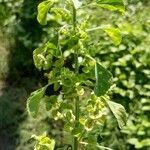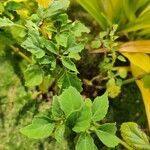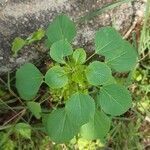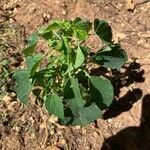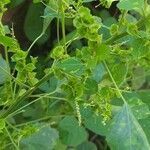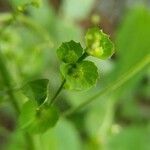Annual herbs, 0.5-1 m tall, monoecious. Branchlets adpressed pubescent. Leaves often ± apically clustered into flat rosette; stipules triangular, ca. 1 mm; petiole slender, 1.5-3.5 cm; leaf blade rhombic-ovate or subovate, 2-3.5 × 1.5-2.5 cm, membranous, pilosulose along veins, base cuneate, margin serrate, apex acute; basal veins 5. Inflorescences axillary, unbranched, 2-7 cm, pilosulose, bisexual; peduncle short; female bracts proximal, 3-7, 1-or 2-flowered, ovate-cordate, ca. 5 mm, margin crenulate, longitudinally many veined, pilose or subglabrous; distal male portion short, slender; bracts ovate-triangular or broadly triangular, ca. 0.5 mm; allomorphic female flower at apex. Male flowers 5-7 per bract; pedicel ca. 0.5 mm; sepals 4, ovate, ca. 0.4 mm; stamens 8. Female flowers subsessile; sepals 3, triangular, ca. 0.5 mm, ciliate; ovary pilose; styles 3, 2.5-3 mm, 5-laciniate. Capsule 3-locular, ca. 2 mm in diam., pilosulose. Seeds ovoid, ca. 1.5 mm, minutely puncticulate. Fl. and fr. Mar-Oct.
Herb, erect, annual, 10–100 cm high; hairs on stems upcurved. Leaves eglandular; petiole c. 5–70 mm long, slender, pubescent; lamina rhomboidal to ovate, 10–70 mm long; base cuneate; margin serrate in apical half; tip acute; venation palminerved, 3-or 5-veined from base, with minutely pubescent veins beneath. Inflorescences usually axillary and solitary, racemose-spicate, often terminated by an abnormal T-shaped flower; female bracts 3–7, 3–4 mm wide. Male flowers: sepals ovate, c. 0.4 mm long; stamens 8. Female flowers ± sessile: sepals triangular, c. 0.5 mm long; styles 2.5–3 mm long. Fruit depressed-globose, 3-lobed, c. 2.5 mm diam., minutely glandular-pubescent. Seeds ovoid, c. 1.5 mm long, 0.9–1.1 mm wide.
Annual or perennial, dwarf shrub, herbaceous, 0.2-1.2 m high; stem simple or sparingly branched, sulcate, shortly pubescent. Leaves membranous, long-petioled, rhomboid-ovate, ovate-oblong, 20-70 x 10-50 mm, base widely cuneate or subtruncate, apex acute, margins serrate, both surfaces sparingly pubescent; petioles up to 76.2 mm long, puberulous. Spikes solitary or paired, up to 63.5 mm long; male bracts minute, faintly puberulous; female bracts accrescent, leafy, up to 5-flowered, suborbicular, obtuse. Female flowers sepals 3, ovate-triangular, sparingly ciliate; styles 3, free from base, short, laciniate; ovary deeply 3-lobed, pilose with tubercle-based hairs. Seeds ovoid, minutely and closely pitted.
Inflorescences up to 9 cm long, spicate, axillary, solitary or paired, mostly female with a few male flowers above, or else all female, often terminated by a long-pedicellate allomorphic female flower; male bracts minute; female bracts accrescent to up to 1.2 × 1.4 cm, transversely ovate to suborbicular, repand-dentate, many ribbed, sparingly pubescent along the ribs, otherwise usually ± glabrous, up to 5-flowered.
Leaf blades 2–7 × 1–5 cm, ovate to ovate-rhombic, acute or subacute at the apex, serrate except towards the base, cuneate at the base, membranous, sparingly puberulous or pubescent to subglabrous or glabrous on both surfaces, sometimes more evenly puberulous along the midrib and main nerves beneath, 5-nerved from the base; lateral nerves in 4–5 pairs.
Female flowers sessile; sepals 3, 1 mm long, triangular-ovate, ciliate; ovary 0.5 mm in diameter, somewhat 3-lobed, sparingly pubescent above; styles 2 mm long, united at the base, laciniate, white. Allomorphic female flowers obovoid, with a pair of fimbriate whorls near the top, pubescent.
Erect herb, up to 0.6 m high. Stems simple below. Leaves ovate, serrate, distinctly petiolate, with petioles up to 55 mm long. Female bracts repand-dentate, 5-11 mm long when mature. Female flowers sessile. Flowers green.
An erect usually simple-stemmed annual, or sometimes a woody subperennial herb or subshrub up to 1.2 m tall.
Male flowers subsessile; buds tetragonal, slightly granulate, yellowish-green; anthers white.
Seeds 1.3 × 1 mm, ovoid, ± smooth, grey, with a flattened linear caruncle.
Fruits 1.5 × 2 mm, 3-lobed, tuberculate, pubescent.
Stipules 2 mm long, linear-filiform, ciliate.
Stems ribbed, and pubescent along the ribs.
Petioles up to 8.5 cm long.
